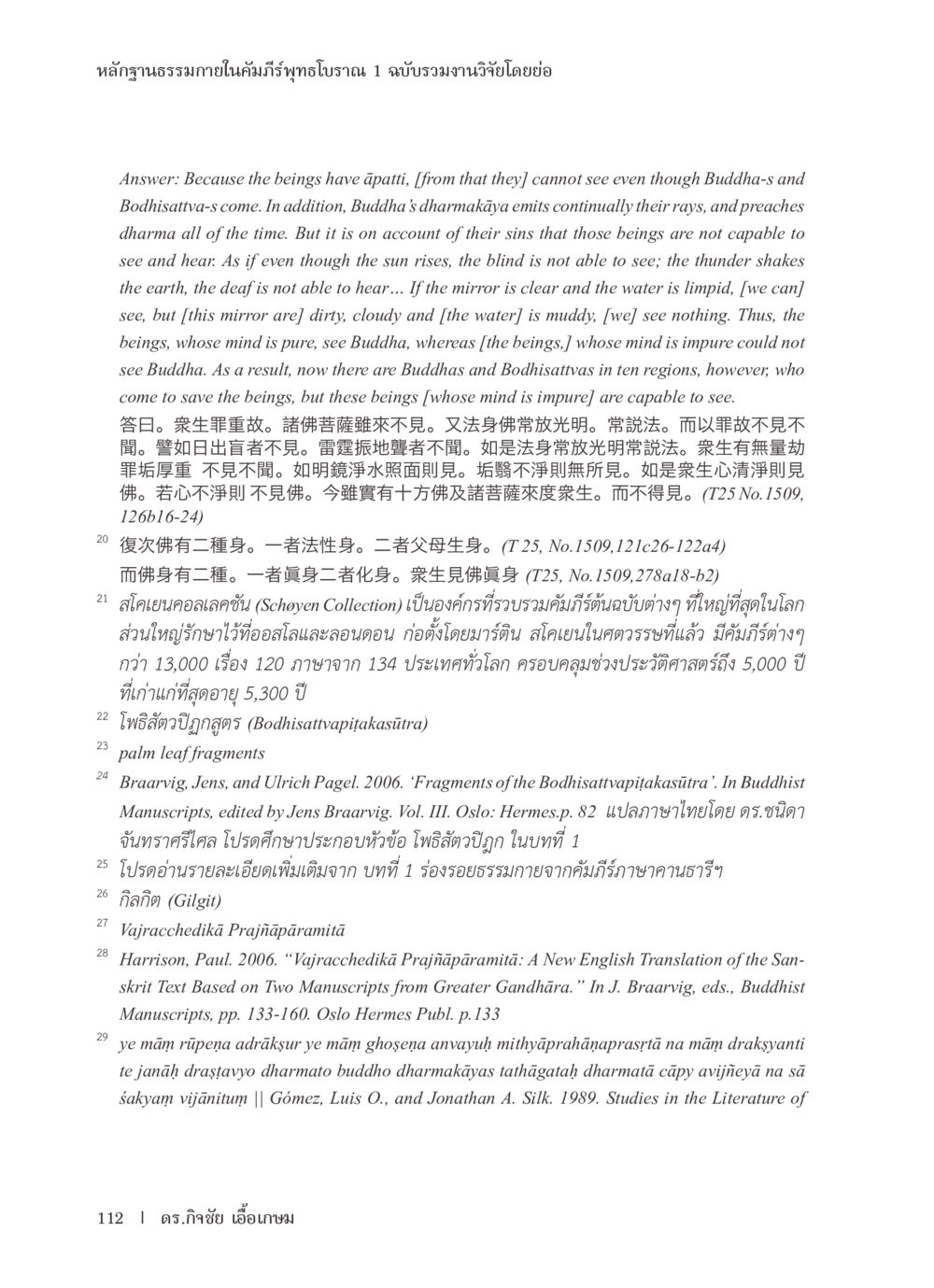หลักฐานธรรมภายในคัมภีร์พุทธโบราณ ๑ ฉบับรวมงานวิจัยโดยอ้อ : หน้า 113/374
หลักฐานธรรมกายในคัมภีร์พุทธโบราณ 1 ฉบับรวมงานวิจัยโดยย่อ : หน้า 113/374 สำรวจหลักธรรมและการมองเห็นพระพุทธเจ้าผ่านข้อคิดทางพุทธศาสนา การทำความเข้าใจธรรมภายในและจิตใจที่บริสุทธิ์.
3 ครั้ง

สรุปเนื้อหา
บทความนี้สำรวจหลักธรรมที่ถูกบันทึกในคัมภีร์พุทธโบราณ โดยกล่าวถึงการที่ beings ไม่สามารถเห็นพระพุทธเจ้าได้เนื่องจากกรรมที่มีอยู่ หากใจไม่บริสุทธิ์ โดยมีการอ้างอิงถึงพระพุทธเจ้าที่ส่งแสงนำทาง แต่การเห็นยังคงถูกจำกัดโดยจิตที่ไม่บริสุทธิ์เนื้อหายังได้กล่าวถึงสองประเภทของร่างกายพระพุทธเจ้า ได้แก่ ร่างกายทางกฎหมายและร่างกายทางพ่อแม่ การศึกษาในด้านนี้จัดทำสรุปชี้ให้เห็นถึงการติดต่อภาควิชาการระหว่างพุทธประวัติในหลายประเทศและการตีความคำสอนที่ถูกต้องว่าด้วยการเห็นและไม่เห็นพระธรรม. สำหรับคนที่มีจิตใจบริสุทธิ์จะได้เห็นและรับฟังธรรม.
หัวข้อประเด็น
-การมองเห็นพระพุทธเจ้า
-จักรวาลทางพุทธศาสนา
-จิตใจบริสุทธิ์
-การศึกษาในคัมภีร์พุทธ
-อาหารสำหรับจิตใจ
ข้อความต้นฉบับในหน้า
หลักฐานธรรมภายในคัมภีร์พุทธโบราณ ๑ ฉบับรวมงานวิจัยโดยอ้อ
Answer: Because the beings have āpatti, [from that they] cannot see even though Buddha-s and Bodhisattva-s come. In addition, Buddha’s dharmakāya emits continually their rays, and preaches dharma all of the time. But it is on account of their sins that those beings are not capable to see and hear. As if even though the sun rises, the blind is not able to see; the thunder shakes the earth, the deaf is not able to hear… If the mirror is clear and the water is limpid, [we can] see, but [this mirror are] dirty, cloudy and [the water] is muddy, [we] see nothing. Thus, the beings, whose mind is pure, see Buddha, whereas [the beings,] whose mind is impure could not see Buddha. As a result, now there are Buddhas and Bodhisattvas in ten regions, however, who come to save the beings, but these beings [whose mind is impure] are capable to see.
答曰。染生罪重故。諸佛菩薩雖來不見。又法身佛常放光明。常說法。而以罪故不見不聞。惟如日出言者不見。雷震地鳴者不聞。如是身常放光明說法。染是身則見佛。若心不淨則不見佛。今雖實有十佛及諸菩薩來度衆生。而不得見。(T25 No.1509, 126b16-24)
復次佛有二種身。一者法性身。二者父母身。(T 25, No.1509,121c26-122a4)
而佛身有二種。一者真身二者化身。染生見佛真身 (T25, No.1509,278a18-b2)
สโคยานอคลาคูชิ (Schoyen Collection) เป็นองค์กรมรีว่ามีคลังลิ้นบัญญัติรบัติในบุตรต่างๆ ที่ญี่ปุ่นที่สุดในโลก ส่วนใหญ่รักษาไว้ที่โอซโลและลอนดอน ก่อสร้างโดยมรีวัด สโคยานในศตวรรษที่แล้ว มีมรีร่างต่างๆ กว่า 13,000 เรื่อง 120 ภาษาจาก 134 ประเทศทั่วโลก ครอบคลุมช่วงประวัติศาสตร์ถึง 5,000 ปี ที่เก่าแก่ที่สุดอายุ 5,300 ปี
โพสิผลปฏิกุสูตร (Bodhisattvapīṭakasūtra)
palm leaf fragments
Braarvig, Jens, and Ulrich Pagel. 2006. ‘Fragments of the Bodhisattvapīṭakasūtra’. In Buddhist Manuscripts, edited by Jens Braarvig. Vol. III. Oslo: Hermes.p. 82 แปลภาษไทยโดย ดร.ชนิดา จันทราศรีโลด โปรดคีย์บประคอยประกอบหัวข้อ โพสิผลปฏิกุ ในบทที่ 1 โปรดอ่านรายละเอียเพิมเติมจาก บทที่ 1 เพื่อรออรรถธรรมภายจากคัมภีร์ราคณะตรัย กิลิติด (Gilgit) Vajracchedikā Prajñāpāramitā
Harrison, Paul. 2006. “Vajracchedikā Prajñāpāramitā: A New English Translation of the Sanskrit Text Based on Two Manuscripts from Greater Gandhāra.” In J. Braarvig, eds., Buddhist Manuscripts, pp. 133-160. Oslo Hermes Publ. p. 133
ye māṁ rūpena adṛaksur ye māṁ ghoṣaṇa anvayu mithyāpradhānaprasṛta nā māṁ draksyanti te jāñāḥ drastavyo dharmato buddha dharmakāyās tathāgato dharmatā câpy avijñeva na sā śakyam vijānitum || Gómez, Luis O., and Jonathan A. Silk. 1989. Studies in the Literature of
หน้าหนังสือทั้งหมด

1

2

3

4

5

6

7

8

9

10

11

12

13

14

15

16

17

18

19

20

21

22

23

24

25

26

27

28

29

30

31

32

33

34

35

36

37

38

39

40

41

42

43

44

45

46

47

48

49

50

51

52

53

54

55

56

57

58

59

60

61

62

63

64

65

66

67

68

69

70

71

72

73

74

75

76

77

78

79

80

81

82

83

84

85

86

87

88

89

90

91

92

93

94

95

96

97

98

99

100

101

102

103

104

105

106

107

108

109

110

111

112

113

114

115

116

117

118

119

120

121

122

123

124

125

126

127

128

129

130

131

132

133

134

135

136

137

138

139

140

141

142

143

144

145

146

147

148

149

150

151

152

153

154

155

156

157

158

159

160

161

162

163

164

165

166

167

168

169

170

171

172

173

174

175

176

177

178

179

180

181

182

183

184

185

186

187

188

189

190

191

192

193

194

195

196

197

198

199

200

201

202

203

204

205

206

207

208

209

210

211

212

213

214

215

216

217

218

219

220

221

222

223

224

225

226

227

228

229

230

231

232

233

234

235

236

237

238

239

240

241

242

243

244

245

246

247

248

249

250

251

252

253

254

255

256

257

258

259

260

261

262

263

264

265

266

267

268

269

270

271

272

273

274

275

276

277

278

279

280

281

282

283

284

285

286

287

288

289

290

291

292

293

294

295

296

297

298

299

300

301

302

303

304

305

306

307

308

309

310

311

312

313

314

315

316

317

318

319

320

321

322

323

324

325

326

327

328

329

330

331

332

333

334

335

336

337

338

339

340

341

342

343

344

345

346

347

348

349

350

351

352

353

354

355

356

357

358

359

360

361

362

363

364

365

366

367

368

369

370

371

372

373

374
หนังสือที่เกี่ยวข้อง
Load More
